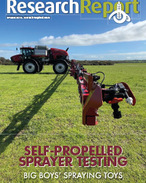This article is 2 years old. Images might not display.
A recent study revealed that there was no difference in pregnancy or fetal rates of ewes that were fed every second day compared to daily in containment, a stock management area where sheep are confined and fed a complete ration.
Senior Lecturer in Ruminant Production with the Charles Sturt School of Agricultural, Environmental and Veterinary Sciences and Senior Research Fellow with the Gulbali Institute for Agriculture, Water and Environment, Dr Susan Robertson, led the study with Honours student Ally Morona.
The study was conducted in 2021 with 800 Merino ewes and the results have recently been published to provide timely information for farmers considering containment this summer/autumn.
Ewes and rams in the study were fed a maintenance ration of barley grain with 10 per cent wheat straw, which is the minimum recommended to maintain rumen function and reduce the risk of acidosis.
Both ewes and rams were introduced to the ration over three weeks and were joined after another two weeks of being fed at different frequencies.
A pregnancy rate of 89 per cent was recorded for ewes fed daily and for ewes fed on alternate days. A similar number of pregnant ewes were scanned with multiple fetuses, 41 percent compared to 44 per cent, indicating that high rates of reproduction are achievable when containment feeding during joining.
"Producers are increasingly feeding ewes in containment to protect pastures during drought or the summer/autumn pasture shortage, and this often coincides with joining," Dr Robertson said.
"Surprisingly, given it is usually ewes which are maintained in containment, no previous research had determined the impact of feeding frequency on reproduction.
"Feeding every second day or three times per week is recommended rather than daily feeding to reduce labour requirements but also to reduce the number of shy feeders, but the impact on pregnancy or scanning rates had not been studied."
Shy feeders (ewes that choose not to eat offered feed) occurred at seven per cent in the study and more were removed after one week of feeding, however, some were removed after five weeks. This highlighted the need for continued monitoring to avoid compromising welfare.
Dr Robertson said long-term monitoring is also essential to ensure the ration fed is adequate.
In this study, ewes fed daily lost 1.3 kilograms live weight compared to 0.3 kilograms for ewes fed on alternate days.
"If this continued long-term, the ration would need to be increased to prevent excessive weight loss," she said.
"Conducting feed tests of feed components is a critical step in calculating how much to feed, but they are an estimate, and sheep weight and condition needs to be monitored as well."
A break in wool (low staple strength) is also a concern for producers following release of sheep from containment. This can occur when there is a sudden change in diet or nutrient intake, or if ewes chase green but limited feed.
"With our results, producers can have more confidence in feeding every second day rather than daily during joining without reducing fetal numbers. This can save in time and labour for feeding," Dr Robertson said.
The study was funded by the Fred Morley Centre at Charles Sturt and by an Australian Wool Education Trust Honours scholarship for Ms Morona.























